The Leica APO-Summicron-SL 35mm F2 ASPH is a fast, moderately wide prime lens for Leica, Panasonic, and now Sigma L-mount cameras.
Leica’s APO designation means that this is one of their best, most highly-corrected models. As a result, the lens has a complex construction consisting of 13 elements, nine of which are anomalous partial dispersion (low-dispersion) glass to control fringing, while a further three are aspherical (two of which dual-aspherical) for monochromatic aberration correction.
Leica has used multi-coatings to reduce stray light and reflections that can result in flare and ghosting, and uses Aquadura coating on the front and rear exterior elements to repel grease and water droplets.
Focusing is completely internal and features quiet and swift autofocus using what Leica call DSD (Dual Synchro Drive), a system composed of two stepping motors. Leica says using two small actuators to independently control two focusing elements allows it to travel the entire focus throw in 250ms.
Users can manually focus by using a ring with a unique magnetic field sensor system that allows for fast and highly precise adjustment, and which resists focus inaccuracies from temperature fluctuations. The lens is weather-sealed, and the focus ring has been especially designed to resist ingress by dust and moisture. Measuring 102mm x 73mm (4.02″ x 2.87″) and weighing 750 grams (1.59 lbs), this lens is aimed squarely at high-end amateurs and professional users.
Key specifications:
- 13 lens elements in 11 groups
- Nine anomalous partial dispersion (ED type) elements
- Three aspherical elements (with two dual-aspherical)
- MC and Aquadura coatings
- Dual stepping motors
- Dust- and moisture-resistant
- 67mm filter thread
- Minimum focus distance: 0.27m (12”)
- Weight: 750 grams (1.59 lb)
Overall lens image quality
Whereas the earlier Leica Summilux-SL 50mmm F1.4 was designed as a large, fast lens with very high image quality, the slower APO-Summicron-SL 35mm F2 ASPH is intended to be lighter and smaller, yet still optimized for superior image quality.
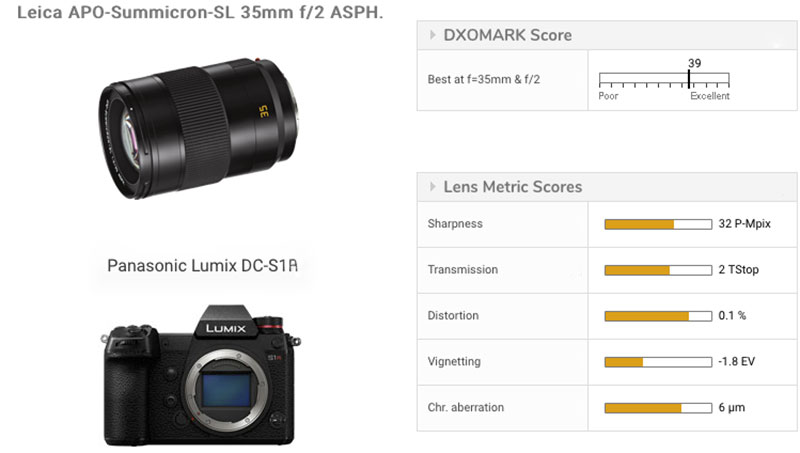
When mounted on the high-resolution L-mount 47MP Panasonic Lumix DC-S1R, the Leica APO-Summicron-SL 35mm F2 ASPH achieves an overall DXOMark rating of 39. That puts it on par with other made-for-mirrorless lenses with a 35mm focal length… but there haven’t been that many made, and we’ve only a handful in our database. Nevertheless, it has high central sharpness from f/2 on and it performs well in retaining sharpness at smaller apertures, where the effect of diffraction would typically be more noticeable.
The APO-Summicron-SL 35mm F2 ASPH has very low levels of distortion. A built-in profile that instructs RAW files in supported processing software to make additional adjustments to handle distortion. These corrections or adjustments are also applied in-camera and to out-of-camera JPEGs. When the profile isn’t supported, it’s possible that the distortion may be noticeable in certain images where strong linear elements are located near the borders of the image frame. Fringing is also corrected by this built-in profile, but this lens is very well corrected for these aberrations anyway.
Vignetting is measured at –1.8EV in the extreme corners; it is visible at the initial aperture, but but is well-controlled, with a relatively gradual fall-off. Although it doesn’t clear entirely, the effect is greatly reduced just one stop down at f/2.8.
The lens’s high transmission is outstanding at T2.0, which is not only useful for filmmakers, but also a measure of well-controlled flare and ghosting.
Image quality compared to competitors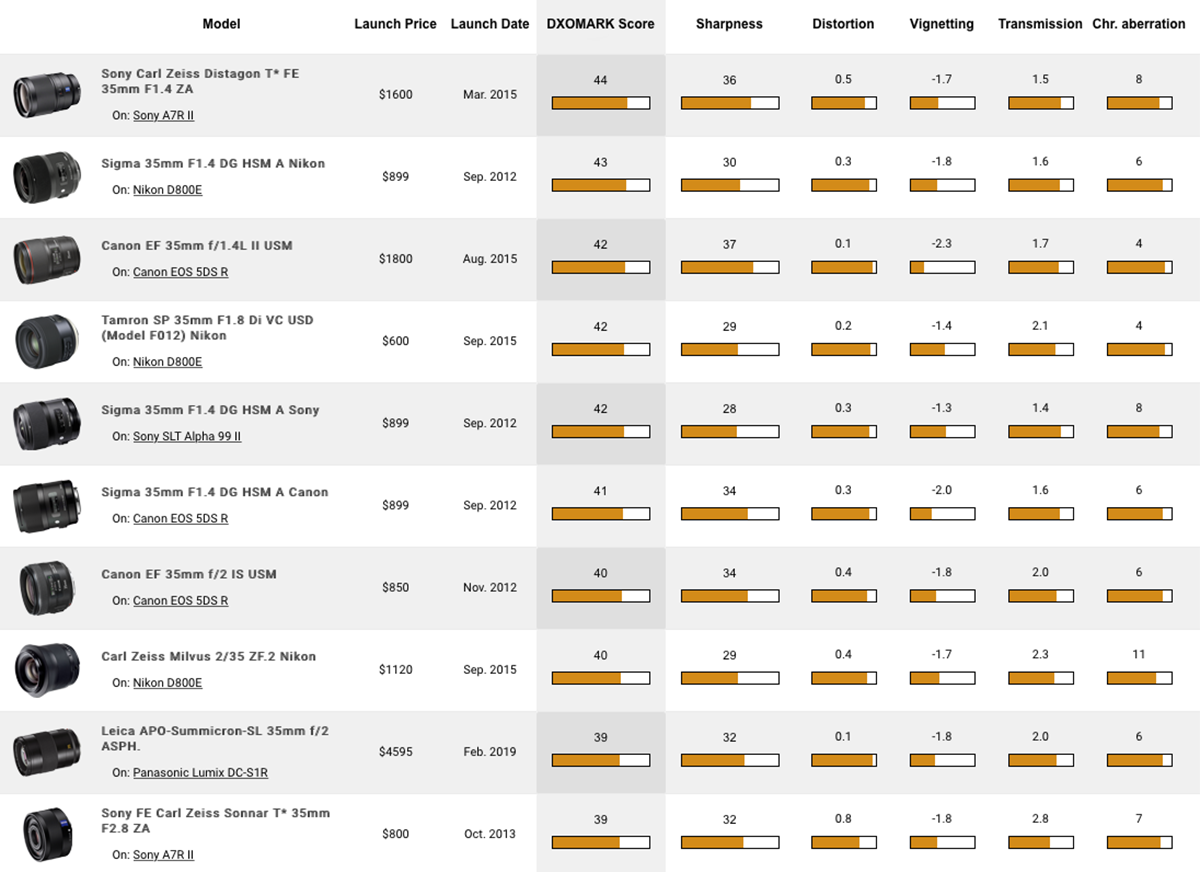
Click here to open our interactive DxOMark lens comparison tool.
Peak sharpness is very good on the 47MP Panasonic Lumix DC-S1R, but it’s still a little behind the Sony Zeiss Distagon T* FE 35mm F1.4 ZA, which has very slightly higher peak sharpness when mounted on the Sony A7R II. Although that’s an older full-frame camera model with a lower pixel count (42MP) than the Lumix DC-S1R, it’s the same or similar sensor to that found in the current Sony A7R III. (We have not yet tested latest version of that camera, the 61MP Sony A7R IV, however, we would expect that a Sony Zeiss/A7R IV combination to have even higher peak sharpness.)
The Canon EF 35mm F1.4L II USM on the 50MP Canon EOS 5DS R is another combination with higher peak sharpness, thanks in part to that high-resolution sensor.
In terms of overall system performance, even the high-regarded Nikon Nikkor Z 35mm F1.8 S on the 45.7MP Nikon Z 7 falls just outside our Top Ten 35mm focal length lens/camera systems (in 11th place), so it’s not listed here. Still, it goes to show just how good these models are when mounted on high pixel-count bodies.
This Leica lens has good chromatic aberration control that is matched only by the L-series Canon, thanks to the latter’s innovative Blue Spectrum Refractive (BR) optics. Typically, APO correction in a lens means that longitudinal fringing is corrected, nevertheless, the 6-micron level of lateral chromatic aberration in this Leica lens is still very impressive.
Further, along with high transmission, it also has very low distortion for this focal length—the same level as some f/1.8 lenses.
Many photographers will end up trying to decide if the high price of the Leica APO is justifiable in terms of its optical performance. It’s certainly one of the best, but there are other combinations with comparable transmission and vignetting, and some with even slightly better, more homogenous sharpness out to the image borders.
You can see all the 35mm lens and various camera combinations using our interactive DxOMark lens ranking tool here.
In-depth comparisons
The Leica APO-Summicron-SL 35mm F2 ASPH is better-corrected than most of the f/1.4 models from its rivals, but they rarely put everything into the design of slower lenses like this. For a more detailed look at the optical performance, then, we’ll compare the Leica lens in combination with the 47MP Panasonic Lumix DC-S1R to the highly-regarded Canon EF 35mm F1.4L USM when mounted on a 50MP EOS 5DS R. We’ll also compare it to the Sony Zeiss Distagon T* FE 35mm FI.4 ZA on the 42MP Sony A7R II.
All these lens and camera models are popular competing choices. (We only recently published our review of the 61MP A7R IV, Sony’s latest high-resolution, mirrorless body, so we did not use it for this lens comparison.) It’s important to remember, of course, that the camera plays an important part in the results. Choosing a lower-resolution body such as the 24MP Sony A7 III will result in a lower overall score, as the sensor contributes to the overall performance.
Sharpness
The Sony Zeiss Distagon T* FE 35mm F1.4 ZA is the leader in our database of 35mm focal length primes when mounted on the high-resolution Sony A7R II, but both it and the Canon EF 35mm F1.4L II USM on the 50MP Canon EOS 5DS R offer superior peak sharpness. Nevertheless, that is only part of the story: how lenses handle sharpness is probably more important to most photographers.
Although a strong performer overall, the Sony Zeiss lens on the A7R II is actually weaker than the Canon combination at f/1.4, but at f/2—the initial aperture of the Leica—all three lenses have similar sharpness (acutance) profiles, with a strong central core of sharpness and a gradual fall-off to the corners.
The Leica/Panasonic combination even has a slight advantage, particularly in the corners. So even the leader in our database doesn’t outperform the Leica at f/2.—Indeed, based on our tests at that aperture, the Sony Zeiss combination is actually the weakest of the three due to its sharpness in the outer field (the outer 50% of the frame) at that aperture.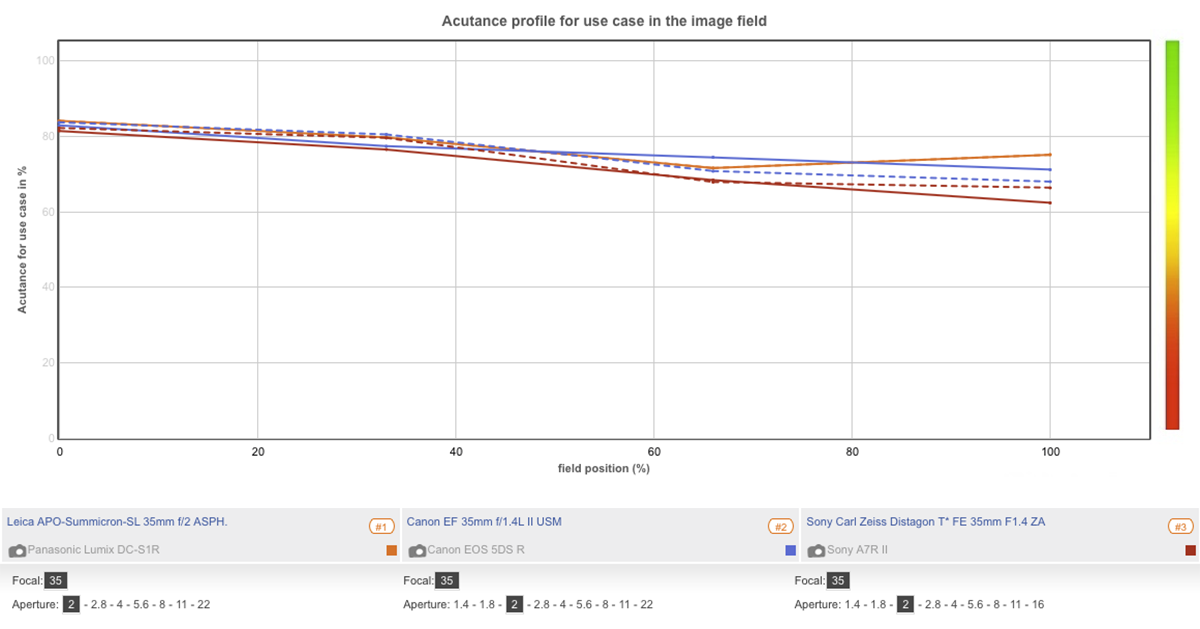
If you look at the sharpness profiles for all three at f/2.8 and at f/4, you’ll see that Leica APO/Panasonic system combination maintains that high central sharpness of over 80% acutance, but away from that central zone, sharpness falls in comparison with the Canon and Sony Zeiss systems.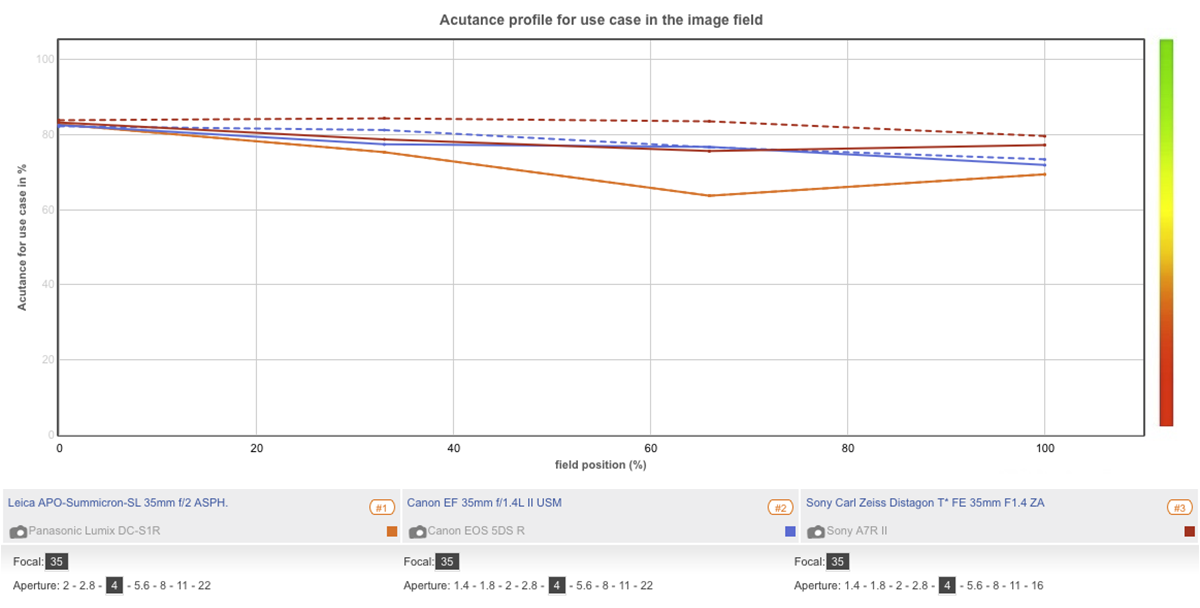
Our results show the Leica APO/Panasonic has very similar results at f/4 as at f/2.8, with lower acutance away from the center, whereas the other two systems show improved sharpness in the outer zones. It’s here at f/4-5.6 that that Sony Zeiss shows its superior sharpness, especially at f/5.6, where its sharpness is measured at 80% acutance from the center out to the corners. (We can also praise the Canon combination for its high sharpness across the imaging field.)
The Leica APO continues to match the two rivals in the center and improves in the outer zones, but sharpness never quite reaches the levels of the Sony Zeiss or the Canon until around f/11, where the effects of diffraction even out the performance. It’s this slightly lower sharpness (acutance) in the outer zones that accounts for the Leica’s rating against the other two strong rivals.
Chromatic aberration
With nine low-dispersion glass elements in its construction, the Leica APO-Summicron-SL lens is very highly corrected for color fringing.
The lateral chromatic aberration (LCA) profile below shows the width of the colored aberration occurring in all three lenses across half the image frame. LCA is measured from the center of the frame at the left (0% field position) to the extreme corner of the frame (at 100%) to the right. To reduce the effect, this new lens uses a built-in correction profile which can’t be turned off in-camera, unlike some models. However, our results show the uncorrected result, so LCA may not be visible at all in out-of-camera JPEGs or in RAW files processed with supported software.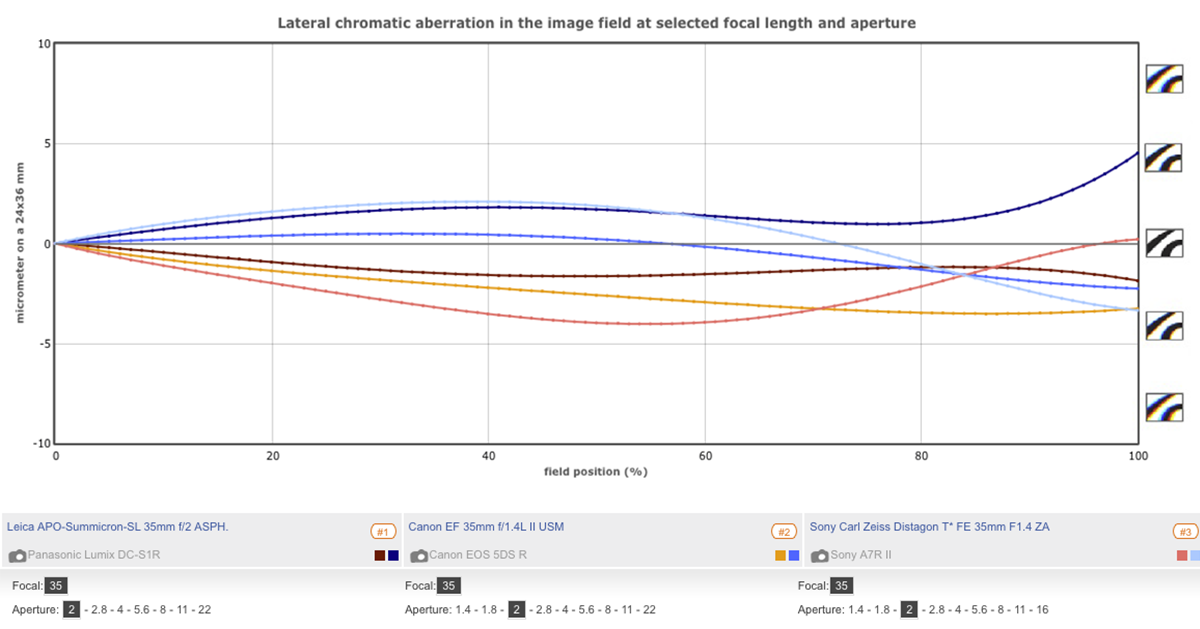
When mounted on the Panasonic Lumix DC-S1R, the Leica APO-Summicron-SL 35mm lens suppresses LCA very well, with a maximum of 6 microns wide measured in our labs. Given that modern zooms such as the Nikkor Z 24-70mm F2.8 S are also well corrected yet still measure around 15 microns at their highest (without their in-built profile applied), you can see that this Leica lens has very low levels of LCA.
However, of the three primes in this comparison, the Canon combination does a slightly better job of suppressing LCA more uniformly across the frame, especially at wider apertures. Even so, like most lenses, LCA is usually at its highest in the corners, and the Canon is no different in this regard.
The Leica-Panasonic combination also has its highest LCA in the corners, but it’s also noticeable—at least in testing—as a ring around the central zone of sharpness. This characteristic is quite common, as LCA rarely shows in the center and is usually suppressed (to a lesser or greater amount) in the mid-to-outer zone, only for it to reappear in the extreme corners. Indeed, the results are similar for the Sony Zeiss combination, with LCA low in the center and rising gently before peaking in the corners at wide apertures.
Geometric distortion
Moderately-wide primes like this typically have some slight barrel-type distortion. This lens’s built-in lens correction profile includes geometric distortion correction, however; and as with lateral chromatic aberration, we’ve measured the results without the correction so that you see the maximum variation for yourself.
Even without applying the correction profile, the Leica APO-Summicron-SL 35mm F2.0 has virtually no distortion, measured at a maximum of just 0.1%.
This level of barrel distortion is unlikely to be noticed in images even with strong linear compositional elements that are parallel and close to the edge of the frame, such as doors or window frames, or even the walls, ceilings, or roofs of buildings.
The Canon rival combination, which also has a correction profile, has the same maximum level of distortion as the Leica/Panasonic combination; however, the Sony Zeiss has higher levels that would be noticeable in images, though it, too, has a profile correction option that would reduce the effect in-camera and with RAW files when processed with supported software.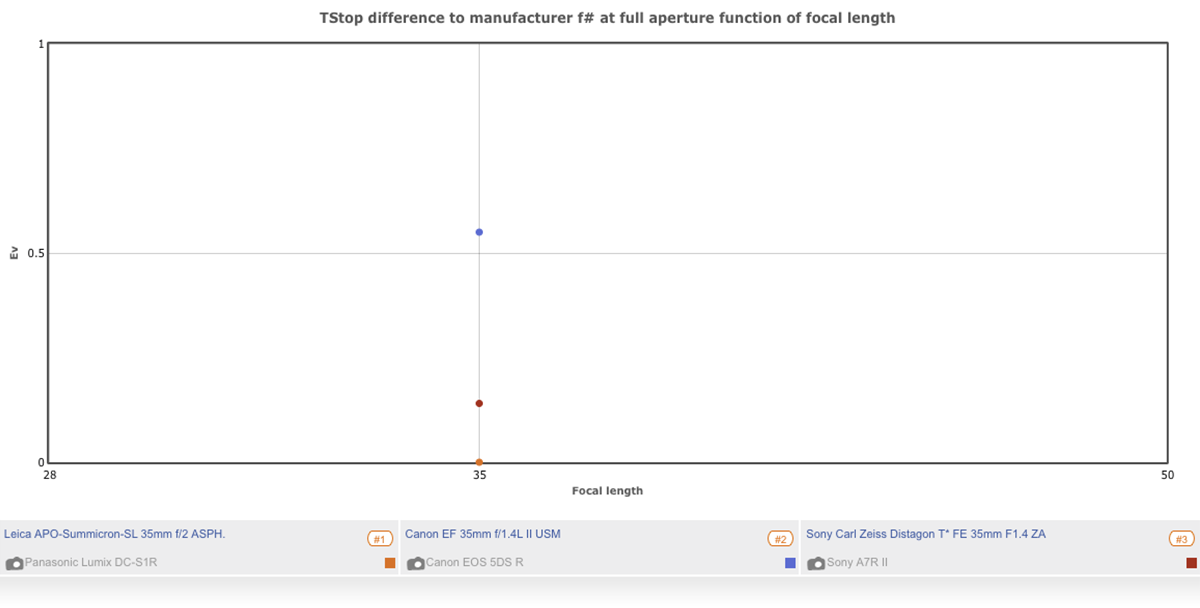
Vignetting (corner shading)
For the Leica APO-Summicron-SL 35mm F2 ASPH and Lumix S1R combination, vignetting measures up to –1.8 EV in the extreme corners at f/2. Although this is a quite gradual effect, vignetting starts to become noticeable from the mid-zone, as can be seen in the graph below. Visually, the effect is very similar to the Canon combination at f/1.4, even though that measures a maximum of –2.3 EV.
Vignetting is noticeable in the Sony Zeiss from the edge of the outer zone, shown in our graph as a shallow slope to begin with, and changing to steep slope as it moves through the outer zones into the corners. It ends up with much less vignetting that either of its rivals, even though its maximum isn’t far behind the Leica at –1.7 EV.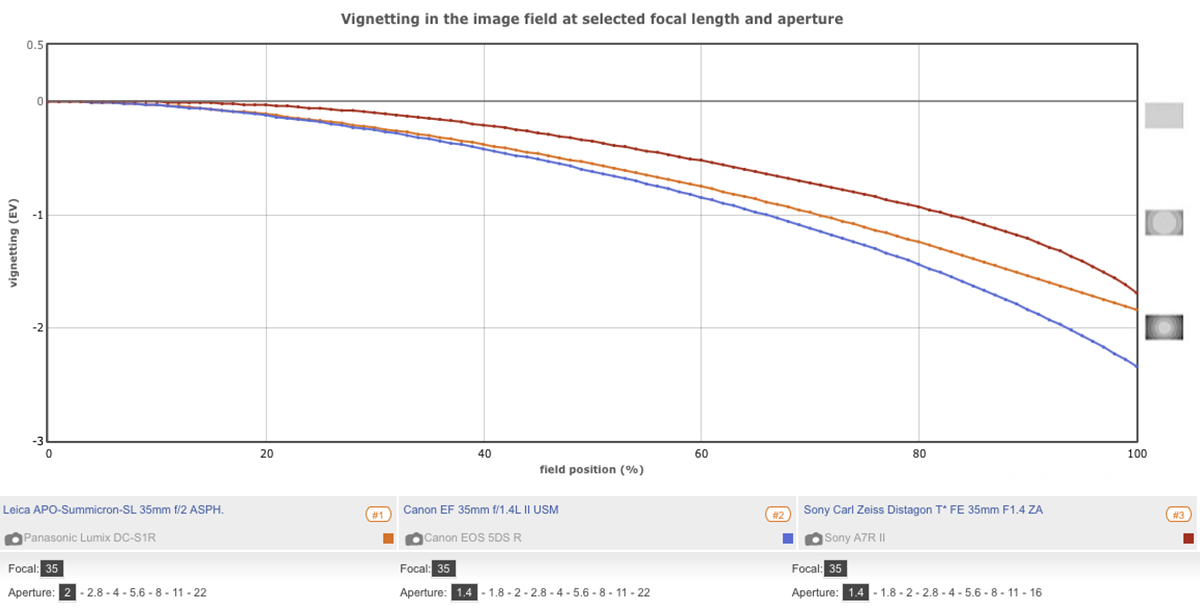
A steep curve indicates a rapid increase in density, which is more likely to be noticed in the image, so a flatter curve is more desirable. With all three lenses set to f/2 (shown below), the faster Canon and Sony Zeiss lenses have less vignetting, but that is to be expected.
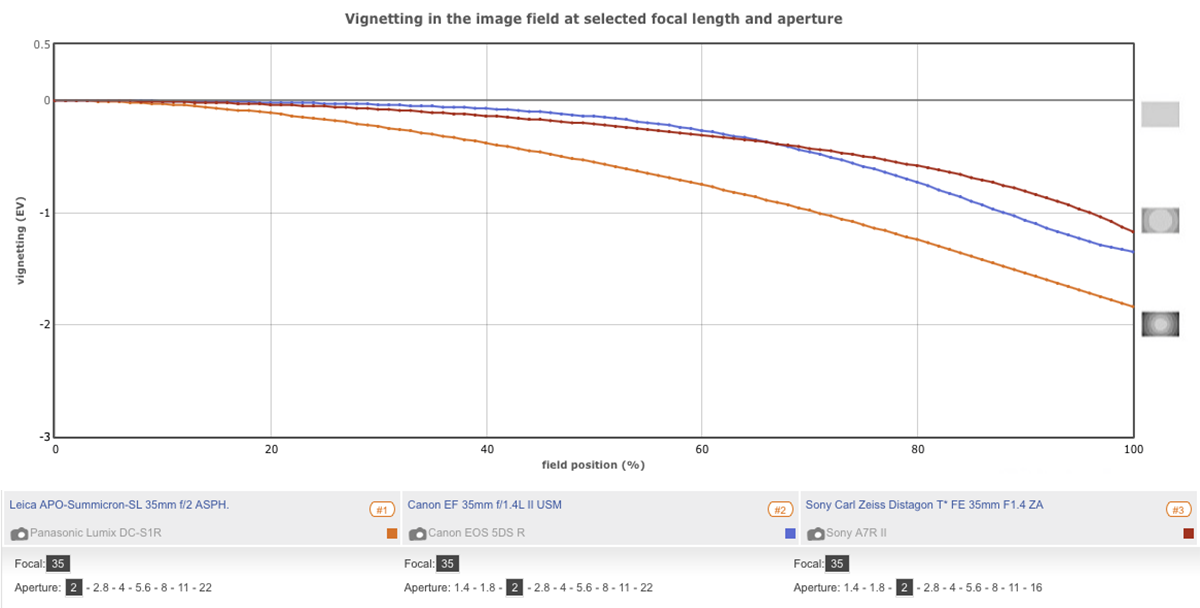
Transmission
Mirrorless cameras are increasingly deployed for video and the Panasonic Lumix DC-S1R is highly capable in that respect. With twin stepper motors, the Leica APO-Summicron-SL lens was designed with video capture in mind; further, the high transmission of this lens, measured as T2.0, means that the coatings are extremely efficient. Transmission close to F-stop values indicates low reflectance, and that typically means low ghosting and flare—important for both still and video capture.
The Leica APO-Summicron-SL 35mm F2 ASPH is almost as bright as some f/1.8 lenses and has higher transmission relative to the manufacturer’s F-stop at full aperture than the Sony Zeiss and the Canon lenses in this comparison.

Conclusion
Many professionals and high-end amateurs consider the 35mm focal length to be an alternative to the 50mm, and as a result, require models with similar or even better optical quality. However, as lens sizes have increased over the years to offer superior image quality, there remains a need for smaller, lighter lenses that offer similar image quality.
Leica’s APO-Summicron-SL series appears to offer just that, and its smaller, lighter f/2 lenses are as well or better corrected than “standard” f/1.4 versions. With such an exotic optical construction, then, the Leica APO-Summicron-SL 35mm F2 ASPH has many attractive qualities, including good sharpness starting at f/2, low LCA, and almost no distortion. It’s also almost as bright as some f/1.8 lenses. All of this comes at price, though, and the $4595 ticket isn’t for the faint-hearted.
In this review, we have compared the Leica APO-Summicron-SL 35mm F2 ASPH mounted on a Panasonic Lumix DC-S1R to its closest rivals from other brands. Remember that the lenses are intended to be used on different camera systems and mounts, so the comparisons are not strictly applicable.
As usual, you can create your own comparisons and in-depth analyses using our interactive image lens comparison tool.


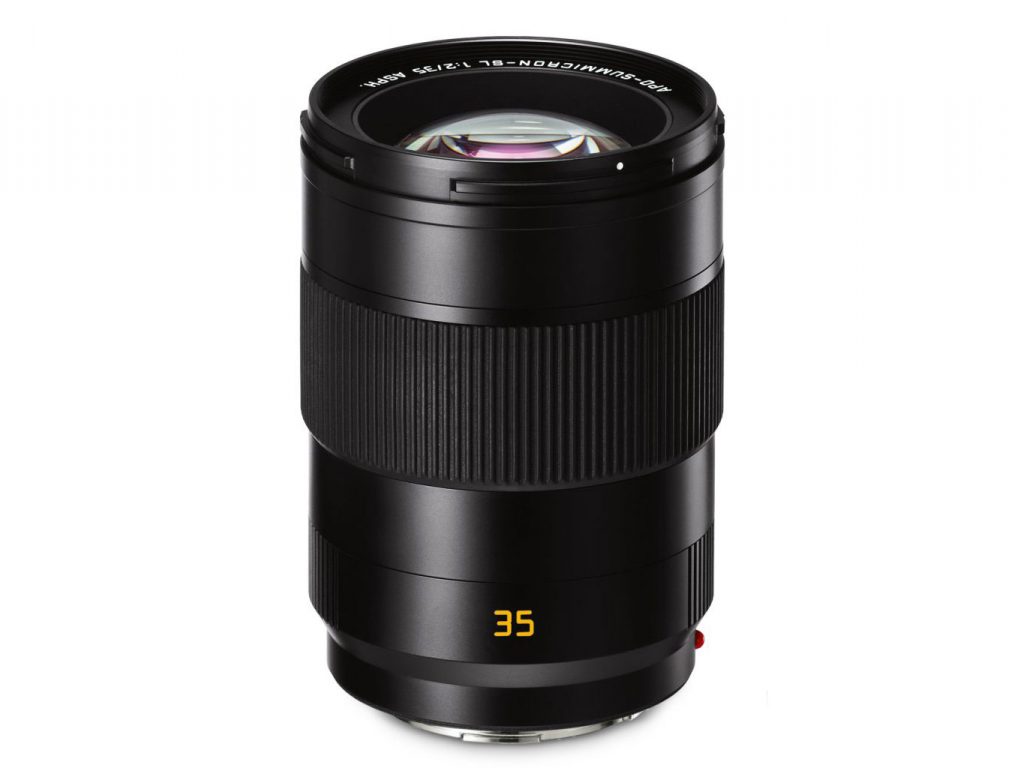


DXOMARK encourages its readers to share comments on the articles. To read or post comments, Disqus cookies are required. Change your Cookies Preferences and read more about our Comment Policy.